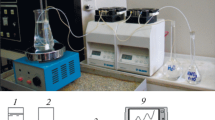Abstract
The role of structural parameters strongly influencing the course of heterogeneous solid-state reactions is established. Owing to the close relationship between the form and reactivity of solids, due emphasis must be given to detailed morphological studies. This allows the derivation of consistent correlations between the reaction mechanism on a microscopic scale and the observed macroscopic changes.
Our present interests are focused on the generation of solids with “tailor-made” specific chemical and physical properties. Starting with suitable precursors and appropriately selected experimental conditions, in particular with reactive gases such as molecular hydrogen, the controlled preparation of, for example, catalytically active finely dispersed metals or alloys, and also binary and ternary metal oxide and sulfide phases is demonstrated.
As indispensable tools, thermoanalytical techniques are applied in combination with mass spectrometry and gas chromatography.
Zusammenfassung
Strukturelle Parameter spielen eine, große Rolle beim Ablauf heterogener Festkörperreaktionen. Wegen der engen Beziehungen zwischen Form und Reaktivität fester Stoffe sind detaillierte morphologische Untersuchungen besonders wichtig. Damit können eindeutige Zusammenhänge zwischen dem mikroskopischen Reaktionsmechanismus und den beobachteten makroskopischen Änderungen abgeleitet werden.
Wir interessieren uns zur Zeit besonders für die Herstellung von Feststoffen mit “massgeschneiderten” spezifischen chemischen und physikalischen Eigenschaften. Ausgehend von geeigneten Vorprodukten und bei günstigen experimentellen Bedingungen, insbesondere beim Arbeiten mit reaktiven Gasen, wie molekularem Wasserstoff, wird die kontrollierte Herstellung z.B. von katalytisch aktiven Metallen oder Legierungen sowie binären und ternären Metalloxid- und -sulfidphasen möglich.
Dabei haben sich thermoanalytische Methoden in Kombination mit Massenspektrometrie und Gaschromatographie als unverzichtbar erwiesen.
Резуме
Установлена роль стр уктурных факторов, затрагивающих ход ге терогенных твердоте льных реакций. Вследствии т есной взаимосвязи ме жду формой и реакционной способн остью твердых тел, особое вн имание должно быть уд елено детальным морфологи ческим исследования м. Это позволило вывест и хорошие корреляции между реакционным механиз мом на микроскопичес ком уровне и наблюдаемым и макроскопичесими и зменениями. Главное внимание авторов было сосредо точено на получении т вердых тел с ”специально пригото вленными” специфиче скими химическими и физиче скими свойствами. Нач иная с выбора подходящих ис ходных веществ и подбора соо тветствующих экспер иментальных условий, особенно, при работе с такими реакционноспособны ми газами, как молекул ярный водород, проведено ко нтролируемое получение каталитич ески активных тонко диспергированных ме таллов или сплавов, на ряду с получением получением двойных и тройных окс идов и сульфидов мета ллов. При этом, как правило, терм оаналитические методы комбинировал ись с масс-спектромет рией и газовой хроматограф йей.
Similar content being viewed by others
References
H. R. Oswald and A. Reller, Ber. Bunsenges. Phys. Chem., 90 (1986) 671.
A. Reller and H. R. Oswald. J. Solid State Chem., 62 (1986) 306.
K. Mori, A. Miyamato and Y. Murakami. J. Phys. Chem., 89 (1985) 4265.
W. Bensch, P. Hug, A. Reller and H. R. Oswald, Mater. Res. Bull., 22 (1987) 577.
W. Bensch, P. Hug, A. Reller and H. R. Oswald, submitted to Mater. Res. Bull.
P. Hug, Ph. D. Thesis, University of Zürich, in progress.
W. Bensch, P. Hug, R. Emmenegger, A. Reller and H. R. Oswald, Mater. Res. Bull., 22 (1987) 447.
H. Topsoe, B. S. Clausen, N.-Y. Topsoe and E. Pedersen, Ind. Eng. Chem. Fundam., 25 (1986) 25.
W. Bensch, G. Stauber-Reichmuth, A. Reller and H. R. Oswald, submitted to Rev. Chim. Min.
G. Stauber-Reichmuth, A. Reller and H. R. Oswald, in preparation.
H. Maurer, Dipl. Thesis. University of Zürich, in progress.
R. D. Shannon, D. B. Rogers and C. T. Prewitt, Inorg. Chem., 10 (1971) 713.
C. T. Prewitt, R. D. Shannon and D. B. Rogers, Inorg. Chem., 10 (1971) 719.
D. B. Rogers, R. D. Shannon, C. T. Prewitt and J. L. Gillson, Inorg. Chem., 10 (1971) 723.
P. Kuhn, A. Reller and H. R. Oswald, submitted to J. Less Comm. Metals.
P. Kuhn, Ph. D. Thesis, University of Zürich, in progress.
Author information
Authors and Affiliations
Rights and permissions
About this article
Cite this article
Oswald, H.R., Reller, A. Structure and form of solids as ruling factors for their thermochemical reactivity. Journal of Thermal Analysis 33, 67–74 (1988). https://doi.org/10.1007/BF01914585
Issue Date:
DOI: https://doi.org/10.1007/BF01914585



